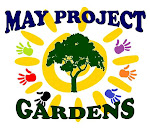Well it's finally done, and what a beauty it is. Our wildlife pond has been completed and now all that's left is to plant up the boundaries and add some plants and fish to the pond. It was not the easiest project to get done but it was very exciting.
Once we had a base map of the May Project Gardens site, we began to play around with the positioning of the element we wanted to put in. One that was a bit tricky was the pond. At first it was suggested that the main function of the pond was to increase the beauty of the gardens and it would therefore be placed in a centre of the site. This later proved to be neither practical nor safe so we therefore decided that, being a permaculture site, that the main function of the pond should be to increase diversity on the site. Our design on paper suggested that the site would be divided up into four main zones.
Zone 1 (Kitchen Garden): this area will require the majority of our attention i.e. most frequently visited. This area would consist of delicate salad crops and herbs and some more fragile vegetables. This zone will be located in close proximity to the main centre of activity i.e. the house.
Zone 2 (Main Crop Garden): this area is only slightly further away from the main centre of activity and will consist of more hardy crops and will also house the polytunnel and maybe chicken if we choose to keep them this year.
Zone 3 (Forest Garden): zone three is exclusive to the forest garden. Where, once establish, no more work is needed to be done on the site apart from the occasional pruning, harvesting and collection of materials to use in craft, mulch, fuel, etc.
Zone 4 (Wildlife Garden): this is the wild zone. In this area we will be aiming to have as little interaction with it as possible. This area will be run by the wildlife, our main focus in this area will be to observe and help maintain balance. It is in this area we have decided to place our pond.
The pond we built is a wildlife pond, meaning that it was designed with the aim of attracting wildlife. We hoped to achieved this in a number of ways;
1. By making the pond large enough to house a large number of different species.
2. By making the pond deep enough to allow certain creatures to survive in the harshness of winter.
3. By providing layers within the pond to accommodate both deep water and shallow water dwelling plants and animals.
4. By providing easy access points into and out of the pond.
Our first design of the wildlife pond was a 2m long 1.5m wide oval shaped design with a series of ledges and slopes reaching a maximum depth approx. 1m.

Pond Design #1: Cross sectional View
This looked easy enough on paper but once we started digging we quickly realised that the size of the pond made it near impossible for us to achieved this design while using only a couple of spades and a mattock. We did not have the luxury of unlimited space so we kept the overall dimensions and removed some of the ledges and the sloping section, and came up with this revised design.

Pond Design #2: Cross sectional View
Day 1
Digging out the hole is the most labour intensive part of pond construction, especially if you are doing it all by hand. We had nearly 300mm of soft top soil, this was easily removed. Then we hit the sub soil which was very heavy clay. It took us all day to get to the depth required all the while trying to maintain our design.

Removal of Top-Soil

Heavy Clay Sub-Soil

The completed hole 2m x 1.5m x ≤1m
We now had a massive hole in the ground and had it covered for a few days and waited for our pond liner and underlay to be delivered.
Day 2
The pond liner and underlay arrived about a week later and when we uncovered the hole we found a few inches, approximately 40lt, of water sitting in the hole. The water, we believed, seeped into the hole from the surrounding soil. This was the only explaination we could come up with as it did not rain at all that week. We believed it to be the level of the water table. I thought that was very interesting. Anyway, the liner and underlay arrived and the first thing we did was to remove all the water in the hole and put down the underlay. This is the pond liners' first line of defence against piercings. The underlay is of similar material to that used by gardeners as weed control fabric. Once this protective layer was in place we then laid the plastic pond liner. We used a very strong 100% rot-proof pond liner with a 40yr waterproof guarantee. This material was very flexible making it easy to mould into the shape of the hole. We used stones and bricks to hold the liner in place while we pleated in the creases for a better fit.

Lined pond with weight supports
All that excavated earth had to go somewhere and so creating a bank around the pond was the next step. We simply dumped the excavated soil back onto the sides of the pond and compacted as we went along. Most of the stones were removed for the compaction process.

Creating the pond banks
Once the majority of the banks were created and the daylight began to leave us we decided to start filling the pond. Ideally we would like to have let the rain do this for us but as I mentioned before there has not been much rain lately. Filling up the pond is the most exciting part of pond building in my opinion. This is the stage where your simple hole in the ground transforms into an actual pond.

Filling in the Pond
The pond was now filled and the banks completed. It was then left uncovered overnight allowing the chlorine in the water to vaporize.
Day 3
The next day we took a ride down to the local park where there is a huge area of swam-land filled with both flowing and stagnant ponds. We collected a few small buckets of pond water together with muck and other debris and added them to our newly built pond. We also added some good soil and organic matter to the pond. Hopefully this will inoculate our pond with microscopic lifeforms. We also added a few different types of rocks which is said to add beneficial minerals to the pond. We wanted our pond to have as natural a look as possible and this meant covering up the edges where the plastic liner was left exposed. We looked at a few other ponds and saw that the edging of choice was either brick or concrete slabs, this was not natural enough for us. We saw a sample where natural stone was also used but these had to be cemented together to stay in place. Then we came across a small woodland pond whose edges were made of woven branches, perfect. We adapted this idea and collected some of the branches we had on our log pile and began to lay them around the edges of the pond. We made sure to leave a few access point for the creatures that will hopefully be using the pond, added a few steps and voilà its' done.

The completed pond
All that's left now is to add some plants in and around the pond, and some very small cold water fish. The plants will help attract predatory insects and also help filter and oxygenate the water. The fish will help to keep the insect (especially mosquitoes) population down, we also hope to have some frogs, toads and newts visiting as well. Another way we are trying to attract more predatory insects into the garden is the building of an insect wall. This simply involves a wooden pallet, standing on its' side, stuffed with old bamboo canes, old logs some with pre drilled holes in them, rocks, bricks, and other bits and pieces. This will provide homes for most types of insects and locating it next to the pond makes it easy to find.

The Insect Hotel under construction

The Wildlife Pond and Insect Wall







